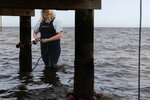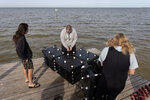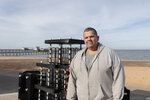FAIRHOPE — After introducing his Eagle Scout Project to The Grand Hotel in Point Clear, John Shell's artificial reefs caught the eye of Mayor Sherry Sullivan, inspiring her to bring this …
This item is available in full to subscribers.
Please log in to continue |





FAIRHOPE — After introducing his Eagle Scout Project to The Grand Hotel in Point Clear, John Shell's artificial reefs caught the eye of Mayor Sherry Sullivan, inspiring her to bring this creation to the City of Fairhope.
Partners for Environmental Progress, The Eagle Reef Projects and the City of Fairhope installed 50 preassembled mini reefs along Coastal Alabama the week of Dec. 5, including 14 reefs installed at locations owned by the city and 36 reefs under wharfs owned by individual homeowners along Mobile Bay, Dog River and the Perdido Bay system.
The installation in Fairhope is the first since The Eagle Reef announced a new partnership with PEP, the University of Alabama Stokes School of Marine and Environmental Sciences and the Alabama Department of Conservation and Natural Resources.
Seven reefs will be installed across the Fairhope area including Pier Street Boat Ramp, the Fairhope Pier and other locations to help protect the waterways.
"We attended the installation at the Grand Hotel, and when I saw it I just knew that Fairhope had to be a part of it," Sullivan said. "Obviously, we have always been supportive of environmental efforts that will help enhance the cleanliness of Mobile Bay, and we believe it one of our greatest natural resources we have here along the Eastern Shore and just really wanted to be a part of it."
The mayor added that not only will these reefs be beneficial to the environment but will also help by educating those who visit.
"We have the Pelican's Nest in town here who brings students down and talks about the bay and the health of the bay," she said. "Just being able to educate them about the reefs and what they do, about oysters and what they do, how to promote cleanliness of Mobile Bay and to educate younger kids about how important it is to protect the waterways."
One of these artificial reefs will be featured at the Fairhope Welcome Center as an educational tool for visitors.
On Dec. 5, people gathered at the north end of the Fairhope Pier on the beach front to watch the installation of these artificial reefs.
Executive director of ocean habitats and the builder of these reefs, David Wolff, said they took years to perfect after multiple failed attempts.
Made with PVC pipe, rope and fluted polypropylene are populated with filter feeders like oysters and barnacles during the first six months after installation. This allows the purification of more than 30,000 gallons of water per day, amounting to 10 million gallons a year, while also attracting fish to the waters surrounding the reefs.
"I started on this in 1995," Wolff said. "It came from an aquaculture experiment we were doing. We kind of branched off into this miniaturized version and it worked awesome."
The executive director added that these reefs last a while and he enjoys going to these reefs years later to check on the sea life.
"To have people go, 'OK cool, I can do something for the environment instead of just hoping I vote for the right person,' it is nice to see and it is fun to come back to these sometimes five or six years later and see all the life and know they would not be there if this was not on the water," Wolff said.
Companies such as Alabama Power are financially sponsoring the installation of these reefs.
"The Alabama Power Foundation has made a donation to help sponsor some of the reefs and supporting and protecting the environment is one of our core values," Alabama Power Public Affairs Manager Beth Thomas said. "This is a wonderful opportunity for us to partner with the partners for environmental progress and our other industry partners to help improve the water quality right here where we live."
John Shell's Eagle Scout Project helped install 175 reefs, and PEP's goal is to have 175,000 when it is all finished. The expanded Eagle Reef Project will filter up to 7.3 billion gallons of water annually and facilitate tens of thousands of fish and crabs every year.